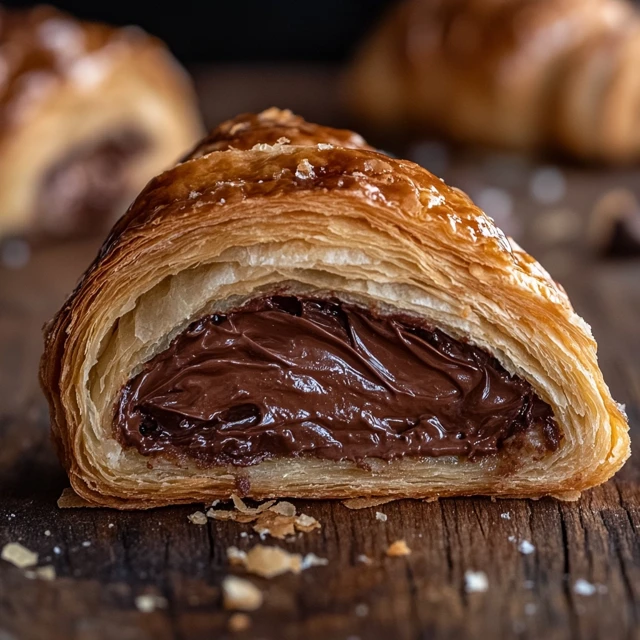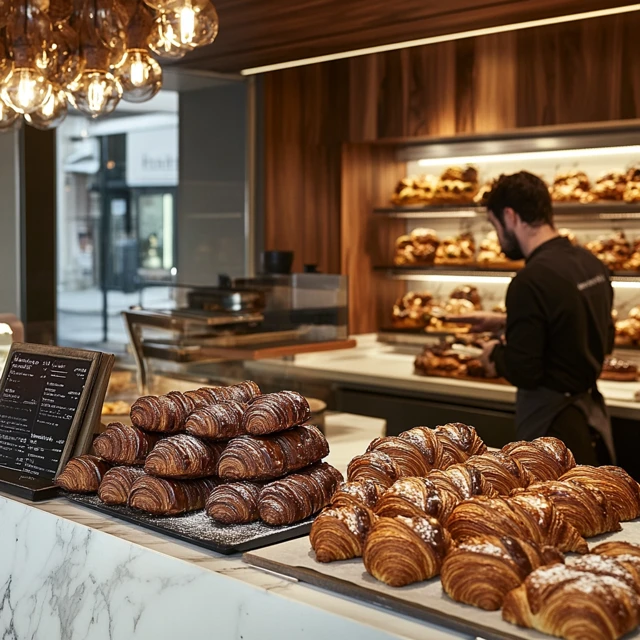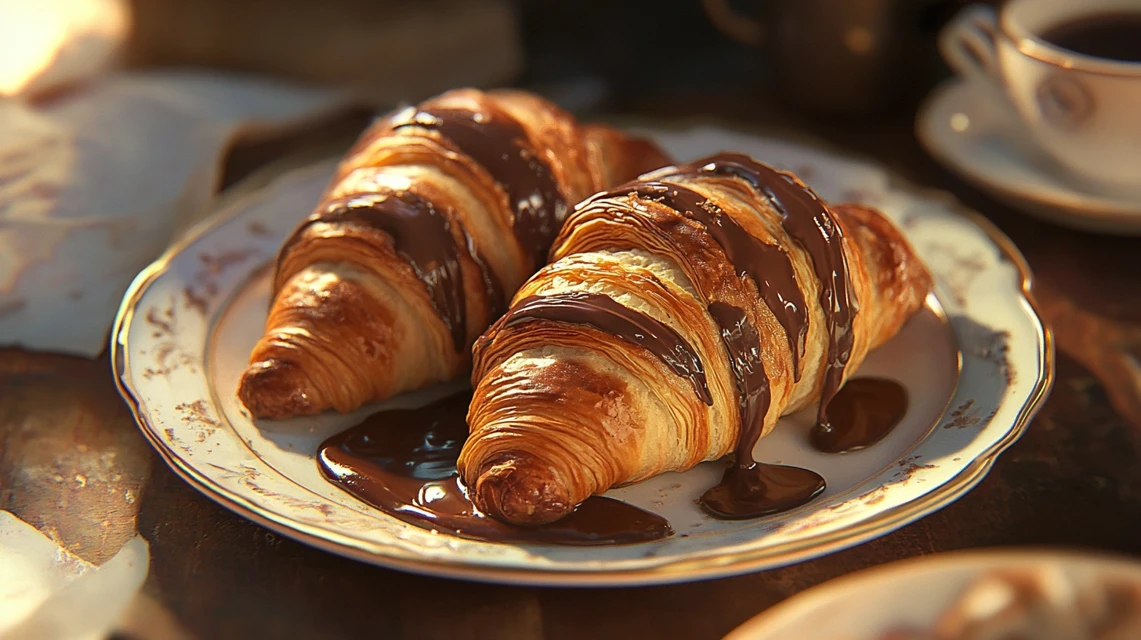Few pastries offer the perfect balance of buttery, flaky dough and rich, melted chocolate like the chocolate croissant. Whether enjoyed as a breakfast treat, an afternoon snack, or a delightful dessert, the chocolate croissant has become a beloved pastry around the world. But where did it come from, and what makes it so irresistible? Let’s explore its fascinating history, essential ingredients, and variations that cater to different dietary needs.
The History of Chocolate Croissant
Understanding the history of the chocolate croissant takes us back to the heart of European baking traditions. This delightful pastry has evolved over centuries to become a global favorite.
Origins in French Pastry Tradition
Although the chocolate croissant is closely associated with France, its roots can be traced back to Austria. The croissant itself originated from the Austrian kipferl, a crescent-shaped pastry that dates back to the 13th century. When Austrian bakers introduced the concept to France in the 19th century, French pastry chefs refined the recipe using laminated dough to create the flaky texture we know today.
The addition of chocolate to croissants came later, inspired by the French love for rich and decadent desserts. The result was the creation of the pain au chocolat, a pastry filled with strips of dark chocolate, which closely resembles what many now call a chocolate croissant.
How Chocolate Croissants Became Popular Worldwide
The chocolate croissant quickly gained popularity beyond France. European immigrants brought the pastry-making techniques with them to various parts of the world, where local bakers embraced and adapted them. In the late 20th century, the rise of artisanal bakeries and the globalization of French cuisine helped chocolate croissants become a staple in cafes, bakeries, and breakfast menus worldwide.
First, you can find chocolate croissants in lots of places – grocery stores, small bakeries, and even fast food places. Plus, they come in many different styles. Some bakers stick to the old recipes, but others try new things by adding different fillings and flavors.
Differences Between Pain au Chocolat and Chocolate Croissant
One of the most common misconceptions is that pain au chocolat and chocolate croissants are the same. While they share many similarities, there are subtle differences:
- Shape: Croissants come in a curved shape like a moon, but pain au chocolat is usually shaped like a rectangle.
- Dough Layers: Croissants often contain more layers of laminated dough, creating an airier texture, whereas pain au chocolat may have a slightly denser feel.
- Chocolate Placement: In a croissant, the chocolate is usually swirled within the dough, whereas pain au chocolat features chocolate sticks placed inside the pastry before baking.
Despite these differences, both pastries offer the same irresistible combination of flaky pastry and rich chocolate.
Ingredients Used in a Chocolate Croissant
Each ingredient in a chocolate croissant helps make it special. The right mix creates those tasty, flaky layers. Let me explain what makes them so good:
Key Ingredients for a Flaky Pastry
To achieve the signature flaky layers and buttery richness of a chocolate croissant, the following ingredients are essential:
- Flour: High-quality all-purpose or bread flour provides structure and elasticity, allowing the dough to hold its shape during the baking process.
- Butter: European-style butter with a high fat content is preferred, as it creates rich, flaky layers when folded into the dough.
- Yeast: This ingredient helps the dough rise, resulting in a light and airy texture. Active dry yeast or instant yeast both work well.
- Milk: Adding milk enhances the flavor and tenderness of the dough, making it softer and more flavorful.
- Sugar: A small amount of sugar adds a touch of sweetness to balance the richness of the butter and chocolate.
- Salt: Essential for enhancing flavor and balancing the sweetness.
- Eggs: They provide structure and add a golden finish to the pastry when brushed on top before baking.
- Chocolate: High-quality dark chocolate with at least 60% cocoa content delivers the best flavor without being overly sweet.
Each ingredient contributes to the final product, ensuring the perfect combination of crisp, golden layers and smooth, melted chocolate.
Choosing the Best Chocolate for a Perfect Croissant

The chocolate used in a chocolate croissant significantly impacts its taste and texture. The best chocolate should be:
- High in Cocoa Content: Dark chocolate with at least 60% cocoa ensures a rich, deep flavor that complements the buttery pastry.
- Low in Sugar: Less sugar prevents the pastry from becoming overly sweet, allowing the buttery flavors to shine.
- Easy to Melt: Chocolate batons or sticks specifically designed for baking hold their shape but melt beautifully inside the croissant.
Some bakers prefer to use chocolate chips or chopped chocolate bars, but using traditional chocolate batons provides an authentic experience with evenly distributed chocolate throughout the pastry.
Alternative Ingredients for Dietary Preferences
This version is simpler and more direct. I removed “dietary restrictions,” “preferences,” “substitutions,” and “accessible” and just explained the main point clearly.
- Dairy-Free Options: Substitute traditional butter with plant-based margarine or coconut oil to make a dairy-free version. Almond or oat milk can replace regular milk.
- Gluten-Free Variations: Gluten-free flour blends with xanthan gum can help create a similar texture, though achieving the signature flakiness may require additional adjustments.
- Healthier Alternatives: To make these treats a bit healthier, you can swap regular flour for whole wheat flour. Also, pick dark chocolate that has more cocoa in it. This way, they’ll still taste great!
Experimenting with these alternatives allows individuals with dietary needs to still enjoy the delicious taste of a chocolate croissant.
check out this https://eassyrecipes.com/category/breakfast/
How to Make a Chocolate Croissant at Home

There’s nothing quite like the aroma of freshly baked chocolate croissants filling your kitchen. While making them at home might seem challenging, following a step-by-step process can make it enjoyable and rewarding.
Step-by-Step Recipe for Beginners
Creating homemade chocolate croissants requires patience and attention to detail. Here’s a simple guide to get you started:
Ingredients:
- 2 ½ cups all-purpose flour
- 1 packet (7g) instant yeast
- 1 cup cold butter (European-style preferred)
- ½ cup warm milk
- ¼ cup sugar
- ½ teaspoon salt
- 1 egg (for egg wash)
- 100g dark chocolate batons
Instructions:
- Prepare the Dough:
- Mix the flour, yeast, sugar, and salt in a bowl.
- Slowly add the warm milk and knead until a smooth dough forms.
- Let it rest for 30 minutes.
- Layer the Butter:
- Roll out the dough into a rectangle.
- Place the butter in the center and fold the dough over it.
- Roll it out again and fold it into thirds. Repeat twice, chilling in between.
- Cut and Fill:
- Roll out the dough into a large sheet and cut it into triangles.
- Place a chocolate baton at the wide end and roll tightly.
- Proofing:
- Arrange the croissants on a baking sheet and let them rise for 2 hours.
- Baking:
- Preheat the oven to 375°F (190°C). Brush with an egg wash.
- Bake for 20-25 minutes until golden brown.
Enjoy your homemade chocolate croissants warm for the best experience!
Common Mistakes to Avoid When Baking
Making chocolate croissants can be tricky, so avoiding these common mistakes will ensure better results:
- Skipping Chill Time: Keeping the dough cold prevents the butter from melting too soon and helps create layers.
- Overproofing the Dough: Too much rising can result in dense, greasy croissants instead of a light, airy texture.
- Using the Wrong Butter: High-fat, high-quality butter is essential to achieving a flaky texture.
Tips for Achieving a Buttery, Flaky Texture
For the perfect pastry, follow these helpful tips:
- Use Cold Ingredients: Keep the butter and dough as cold as possible to prevent it from melting prematurely.
- Roll Evenly: Ensure even thickness while rolling to create uniform layers.
- Bake at the Right Temperature: A high temperature helps the croissants puff up and develop a crisp, golden crust.
check out this https://eassyrecipes.com/category/breakfast/
Nutritional Value of Chocolate Croissant
Although chocolate croissants are a delicious indulgence, it’s important to understand their nutritional content.
Calories and Macronutrient Breakdown
On average, a standard-sized chocolate croissant contains:
- Calories: 300-400 kcal
- Carbohydrates: 40-50g
- Fats: 15-20g (mostly from butter)
- Protein: 6-8g
While they are high in calories and fats, they can still fit into a balanced diet when consumed in moderation.
Healthier Substitutes for a Guilt-Free Treat
If you’re looking to enjoy a healthier version of chocolate croissants, consider these alternatives:
- Use Whole Wheat Flour: This adds fiber and nutrients without compromising flavor.
- Reduce Butter: Substitute part of the butter with healthier fats like coconut oil.
- Dark Chocolate: Choose chocolate with at least 70% cocoa to reduce sugar intake.
How to Enjoy in Moderation
To enjoy chocolate croissants without overindulging:
- Have them as an occasional treat rather than a daily habit.
- Pair them with protein-rich foods like Greek yogurt to balance macronutrients.
- Stick to smaller portions and savor each bite mindfully.
check out this https://eassyrecipes.com/category/breakfast/
Popular Ways to Enjoy Chocolate Croissants
Chocolate croissants are versatile and can be enjoyed in various settings.
Perfect Pairings with Coffee and Tea
Pairing your croissant with the right beverage can enhance the experience. Some popular choices include:
- Coffee: A rich espresso or a creamy latte pairs well with the buttery pastry.
- Tea: Herbal or black teas complement the sweetness without overpowering it.
- Milk: A classic pairing that enhances the chocolate’s creaminess.
Best Occasions to Serve Chocolate Croissants
Chocolate croissants are perfect for many occasions, such as:
- Breakfast Gatherings: A sophisticated option for brunch with friends.
- Dessert Treat: Serve warm with a scoop of vanilla ice cream.
- Special Celebrations: Ideal for birthdays, anniversaries, and other events.
Savory vs. Sweet Variations
While chocolate croissants are traditionally sweet, some enjoy experimenting with savory fillings such as:
- Cheese and Spinach: A flavorful twist with a balance of textures.
- Ham and Cheese: A savory, satisfying option for a quick meal.
- Nutella and Banana: A delightful mix of fruit and chocolate.
Where to Buy the Best Chocolate Croissants
If you prefer to buy chocolate croissants rather than bake them, there are plenty of options.
Top Bakeries Known for Chocolate Croissants
Some of the best bakeries worldwide known for their exceptional chocolate croissants include:
- Ladurée (France): Famous for its authentic French pastries.
- Dominique Ansel Bakery (New York): Known for innovative takes on classic pastries.
- Maison Kayser (Multiple Locations): A trusted name in artisanal French baking.
Buying Pre-Made vs. Freshly Baked Options
When purchasing chocolate croissants, you can choose between pre-made frozen options and freshly baked versions.
- Pre-Made: Convenient for home baking with minimal effort.
- Freshly Baked: Provides the best flavor and texture, ideal for immediate enjoyment.
Online Ordering and Delivery Options
Many bakeries now offer online ordering and delivery services, allowing you to enjoy high-quality chocolate croissants from the comfort of your home. Some popular platforms include:
- Goldbelly: Delivers bakery-fresh croissants from top-tier establishments.
- Local Bakeries: Many artisanal shops offer direct-to-door delivery services.
- Grocery Store Brands: Well-known brands like Pillsbury provide ready-to-bake options.
FAQs About Chocolate Croissants
Chocolate croissants are a popular pastry enjoyed worldwide, yet many people have questions about their name, ingredients, and baking methods. Below are answers to some frequently asked questions to help you better understand this delicious treat.
What Is a Croissant with Chocolate Called?
In many parts of the world, a croissant filled with chocolate is known as pain au chocolat. Originating from France, this term translates to “chocolate bread” and refers to the traditional rectangular-shaped pastry made with laminated dough and filled with chocolate batons.
On the other hand, in countries outside of France, particularly in English-speaking regions, this pastry is often called a chocolate croissant. While the two terms are sometimes used interchangeably, the classic pain au chocolat maintains a different shape and structure compared to the crescent-shaped croissant commonly associated with the term.
Why Do Americans Call It a Chocolate Croissant?
In America, people started calling these treats chocolate croissants because they know and love the curved shape of regular croissants. So when bakeries wanted to sell them, they used this name even though French bakers make their pain au chocolat in a rectangle shape.
First, Americans make their chocolate croissants in many different ways. They might drizzle chocolate on top, mix chocolate chips into the dough, or shape them like crescents instead of rectangles. So that’s why people started calling all these different treats chocolate croissants.
Despite the difference in naming conventions, the delicious combination of buttery, flaky pastry and rich chocolate remains the same, whether called pain au chocolat or chocolate croissant.
What’s the Difference Between Puff Pastry and Croissants?
While both puff pastry and croissant dough are known for their light, flaky texture, there are key differences between the two in terms of ingredients and preparation:
- Ingredients:
- Croissant dough includes yeast, milk, and sugar, which contribute to a slightly sweet and airy texture.
- Puff pastry does not contain yeast or sugar, relying solely on layers of butter and dough to create its crisp texture.
- Texture:
- Croissants have a tender, flaky texture with a slightly chewy interior, thanks to the yeast fermentation.
- Puff pastry is crispier and more delicate, with a crunchier bite due to the absence of yeast.
- Preparation:
- Croissant dough requires proofing (allowing the dough to rise) before baking, which enhances its soft layers.
- Puff pastry does not require proofing, making it quicker to prepare but resulting in a different texture.
So even though these doughs are alike in some ways, each works better for different things. Croissant dough makes softer, more bread-like treats, but puff pastry creates crispy treats like tarts and turnovers.
Can You Use Pillsbury Croissants as Puff Pastry?
Pillsbury croissants come in tubes of ready-to-bake dough that you can find in most stores, but they’re not real puff pastry. You can use them for quick and easy homemade treats, though they’re different in a few ways. Here’s what to know:
- Structure: Pillsbury croissant dough contains leavening agents, making it softer and more bread-like compared to the crisp texture of puff pastry.
- Flavor: The dough tends to be sweeter and more buttery, which works well for certain recipes but may not provide the exact texture of puff pastry.
- Versatility: While Pillsbury croissants can be used in some recipes that call for puff pastry, they may not achieve the same light and crisp results. For flaky, crispy pastries, it’s best to use store-bought puff pastry or make it from scratch.
When you’re in a hurry, you can use Pillsbury croissants to make turnovers or stuffed pastries. But for fancy desserts, you should pick puff pastry instead since it works better.
Conclusion
Chocolate croissants, whether called pain au chocolat or by their Americanized name, remain a beloved pastry worldwide. Understanding the differences in terminology, baking techniques, and ingredient choices allows you to enjoy them in various ways—whether you prefer the traditional French version or a modern twist.
First, you can bake chocolate croissants at home or try different types of dough. Or you can just buy them from a store. Either way, you’ll love how the sweet chocolate and buttery pastry taste together. These treats work well for any time of day!

